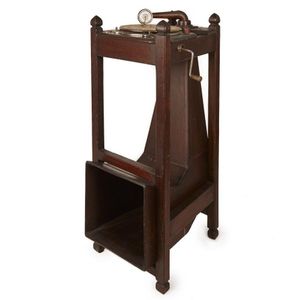Victorian Mirrored Inlaid Sideboard with Marble Top
You must be a subscriber, and be logged in to view price and dealer details.
Subscribe Now to view actual auction price for this item
When you subscribe, you have the option of setting the currency in which to display prices to $Au, $US, $NZ or Stg.
- Inlay - Decorative patterns inserted into the main body of a piece of furniture, generally in wood of contrasting colour and grain, though brass, ivory, ebony, shell and sometimes horn have been used. Inlay may consist of a panel of well figured timber inset into a cabinet door front, geometric patterns, or complex and stylized designs of flowers, swags of foliage, fruits and other motifs. As a general rule, in pieces where the carcase is constructed in the solid, the inlay is relatively simple such as stringing, cross banding and herringbone banding. Where more elaborate and decorative work was required veneer was used. Inlay has been fashionable from at least the latter half of the 17th century, when a variety of elaborate forms were developed
- Rail - A term used by cabinet makers for the horizontal sections of the frame of an item such as a chair or settee which have a front rail, a back rail and two side rails, and also on a door or carcase, where the rails are joined to the vertical framings.
- Parquetry - Parquetry is inlay laid in geometric patterns, the contrast being achieved by the opposing angles of the grain and veneers. The herringbone pattern is the most commonly used in flooring, but this is almost never seen in furniture - the patterns used are more complex and unlike flooring, can include several different varieties of timber.
- Victorian Period - The Victorian period of furniture and decorative arts design covers the reign of Queen Victoria from 1837 to 1901. There was not one dominant style of furniture in the Victorian period. Designers used and modified many historical styles such as Gothic, Tudor, Elizabethan, English Rococo, Neoclassical and others, although use of some styles, such as English Rococo and Gothic tended to dominate the furniture manufacture of the period.
The Victorian period was preceded by the Regency and William IV periods, and followed by the Edwardian period, named for Edward VII (1841 ? 1910) who was King of the United Kingdom and the British Dominions and Emperor of India for the brief period from 1901 until his death in 1910. - Stringing - Fine inlaid lines, in contrasting colour to the carcase timber, found mainly on furniture made in the styles of the later 18th and early 19th centuries. Stringing, which may be of satinwood, pine, ebony, horn, brass or occasionally ivory, is found principally on drawer fronts, around the outer edges of usually tapered legs and French bracket feet, around the edges of inlaid panels and between the joint of the cross banding and carcase timber on table tops, chests of drawers, cabinets etc. The effect is to emphasize the line of the piece and add to the impression of lightness and elegance. Stringing also occurs in Sheraton-revival-style furniture of the later 19th and early 20th centuries.
This item has been included into following indexes:
-
sideboards
- mirror back 138
- Victorian 406
Visually similar items

A pair of marble-mounted hardwood side chairs, 19th/20th century, each with a shaped and moulded back inset with a circular white marble plaque, and joined to the solid seat with short curved arms pierced and carved as scrolling lingzhi fungus stems, the b

A Victorian oak hall chair, with arched, panelled back, solid seat and turned front legs.

An impressive 19th century French amboyna pedestal desk. The shaped top with an inset tooled leather, above a central frieze drawer flanked by pedestals, each with three drawers and ormolu swag decoration, the reverse with two fine marquetry panels of two

A rare standing upright gramophone by Chapman Taylor, the Garrard Super turntable with Beltona Peridulce reproducer. Wooden horn and sound box below with four column legs. (turntable deficient), height 1,20 cm
